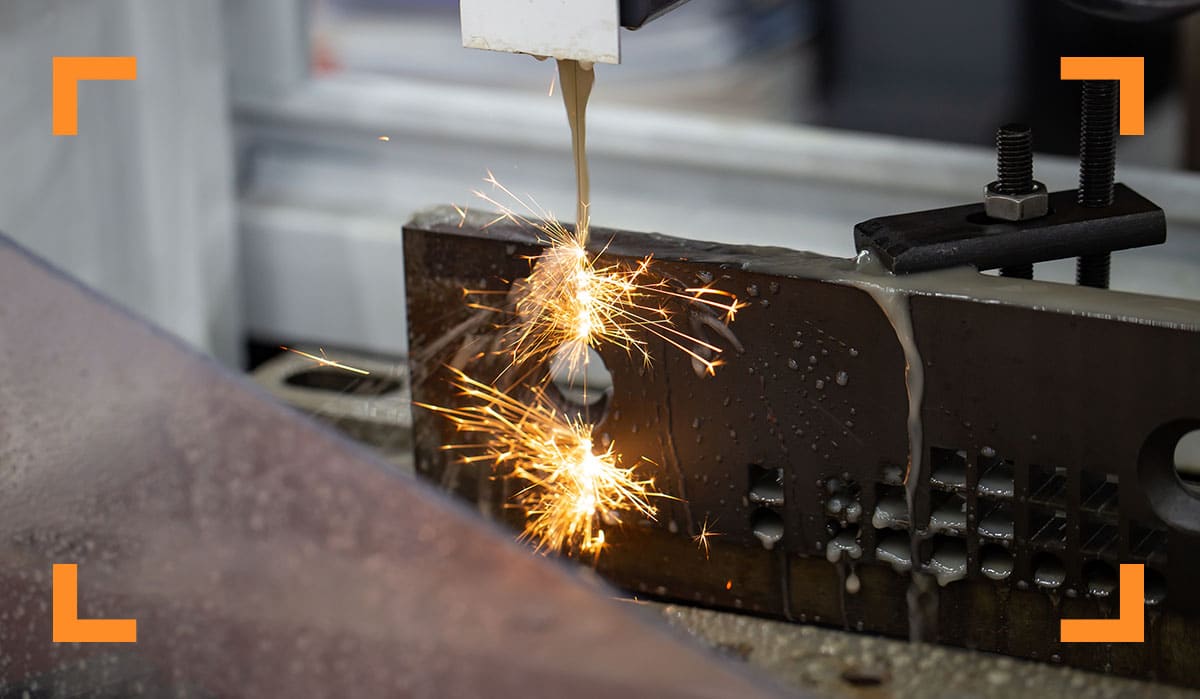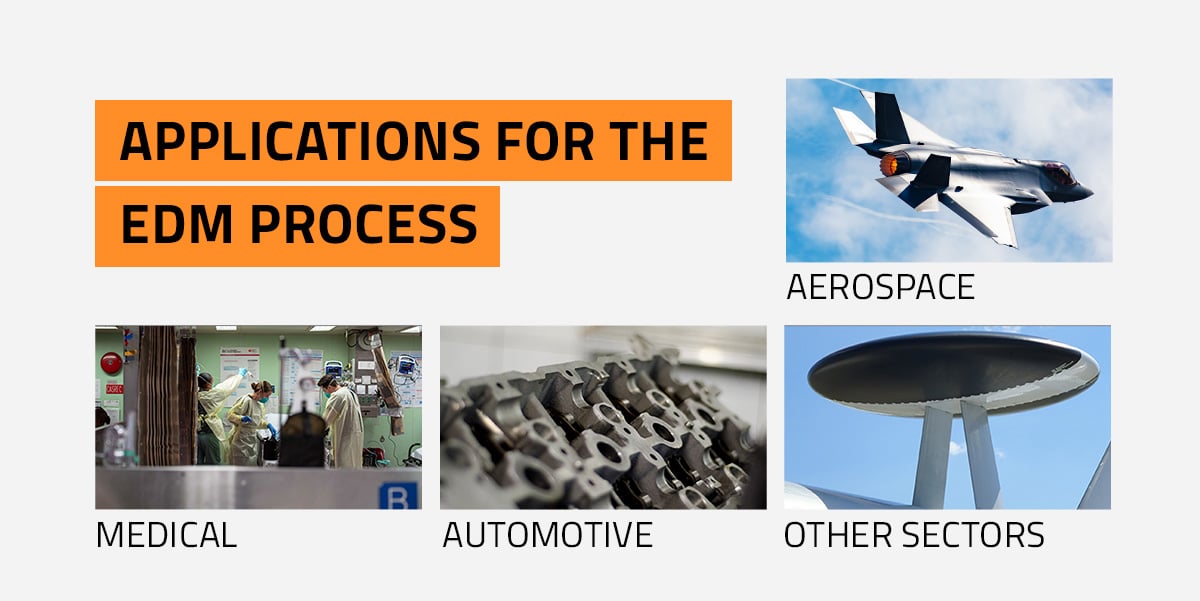What Is Electrical Discharge Machining?
September 23, 2025

Industries needing to meet tight tolerances can turn to non-traditional machining methods to ensure workpiece precision and performance. Electrical discharge machining (EDM) is known for its ability to create complex geometries and fine details, making it valuable for critical industries like medical, aerospace, electronics and automotive.
EDM Explained
Electrical discharge machining is a nontraditional machining method that uses electrical sparks to remove materials from conductive workpieces. This type of machining maintains fine surface finishes, making it suitable for delicate or intricate pieces. While traditional machining relies on mechanical forces, EDM removes materials through thermal forces.
During the process, the workpiece and an electrode are submerged in dielectric fluid. Rapid electrical discharges occur between the electrode and the workpiece, with each spark removing a small portion of material until the workpiece achieves the desired shape.
This machining method offers high precision, making it suitable for various applications across critical industries like medical, aerospace and automotive. Advantages of EDM include:
- Enhanced design freedom: This machining method allows teams to cut complex shapes and depths that would be challenging or impossible to achieve with traditional methods. Engineers and designers can create thin walls and deep cavities without the limitations of milling cutters or drills.
- Reduced distortion: EDM is a noncontact process, which means the tool and workpiece never physically touch. The lack of contact eliminates mechanical stresses and forces that can cause distortion, deformation and warping in traditional processes. The workpiece is also not subjected to cutting forces or clamping pressures, ensuring the integrity of intricate and delicate pieces.
- Increased precision: The controlled nature of the electrical discharges in EDM allows for highly repeatable results. The process can achieve tight tolerances, making it valuable for applications where even the slightest variations can affect assembly or performance. The lack of mechanical force further enhances accuracy by minimizing risks of tool deflection or vibration during traditional processes.
- Improved surface finish quality: EDM creates smooth, uniform finishes with minimal burrs or cracks. This improved surface quality enhances component appearance and can improve part performance and resistance to corrosion or wear.
Different Types of EDM Machines and Processes
Understanding the EDM manufacturing method begins by recognizing the different types of machines and processes available. There are three types of electrical discharge machining processes — die sinking EDM, wire EDM and hole drilling EDM.
What Is Die Sinking EDM?
Die sinking, or ram EDM, is best for creating parts with complex cavities. This method uses graphite or copper electrodes, electric sparks and a dielectric fluid, typically hydrocarbon oil. At the beginning of the process, an electrode forms the die by producing the reverse shape of the cavity. A voltage is induced between the workpiece and the die while submerged in the dielectric fluid.
The die slowly lowers toward the piece until a spark jumps to signal an electric breakdown. This step melts material away from the piece, and the fluid carries the ejected particles away. This method relies on a series of high-frequency sparks, each removing small amounts of material. As materials melt, the desired shape begins to form until a precise cutout remains.
What Is Wire EDM?
Wire EDM is used broadly to cut precise 2D and 3D profiles through conductive stock. For wire EDM processes, teams replace the die with an electrically charged wire to work as the electrode. The thin wire ensures precise cutting by following a programmed path.
There is no direct contact between the workpiece and wire during the cutting process, so the material shape is not subject to distortion from the wire. When the charged wire reaches the correct distance to the workpiece, a spark jumps between the two to melt a portion of the workpiece.
What Is Hole Drilling EDM?
The hole drilling EDM technique machines holes into a workpiece. This method can create deep and small holes that do not require deburring after completion. Hole drilling EDM relies on the same principles as die sinking EDM, but the process uses a tubular electrode to flush dielectric through the center for deep, small, high-aspect-ratio holes. As the cylinder moves deeper into the workpiece, dielectric liquid, typically deionized water, feeds into the cutting area.
Hole drilling EDM is suitable for a range of conductive materials, regardless of hardness. It allows teams to create accurate and repeatable holes for components with tight tolerances. This process also results in minimal burrs, requiring minimal post-processing steps.
Applications for the EDM Process
The precise and repeatable nature of EDM makes this method suitable for a range of applications. Teams that need to meet tight tolerances or work with small, delicate workpieces can benefit from EDM techniques. Applications for EDM in manufacturing include:
- Aerospace: The aerospace industry requires complex, high-precision components from materials like titanium and steel. EDM enables the production of lightweight, high-strength parts that meet performance and reliability needs in critical flight systems. EDM is used to drill film-cooling holes in turbine airfoils, machine fuel‑injector nozzles and form accessible internal features in engine components where an electrode or wire can reach.
- Medical: Medical teams rely on EDM for the fabrication of surgical instruments, dental components, micro-scale devices and orthopedic implants. EDM’s ability to create intricate features in biocompatible materials is invaluable. EDM techniques are especially beneficial for producing minimally invasive tools and custom implants while ensuring the functionality and safety of medical devices.
- Automotive: EDM can manufacture high-precision components in the automotive industry, such as prototype gears, specialty gears and precision tooling. This type of machining can produce lightweight parts with high-performance capabilities to improve vehicle performance and fuel efficiency.
- Other sectors: Additional sectors can also benefit from EDM processes. EDM in metal fabrication has use cases in electronics, communications and energy. This method can produce micro-components for electronics, machine parts for pumps and turbines, and more.

Challenges and Possible Limitations of EDM
Despite the immense opportunities for EDM across critical industries, this machining method has limitations. Notable challenges with EDM include:
- Slower material removal: EDM is slower than conventional processes like turning or milling. The process relies on a series of small electrical discharges, which gradually erode materials from the workpiece. This can create challenges for high-volume production.
- Electrode wear: The electrodes in the EDM process also erode as electrical discharges occur. This wear can affect the consistency of machined features, especially during complex or long-lasting operations. Frequent electrode replacement or re-machining may be necessary to maintain desired results, which can increase operational costs and downtime.
- Dielectric handling: Dielectric fluids, such as deionized water or oil, are critical for EDM processes. These fluids facilitate the sparking process and carry materials away from the workpiece. However, managing this fluid involves monitoring for contamination, regular filtration and safe disposal. Improper handling can reduce machine efficiency and create environmental concerns or operator health hazards.
- Material compatibility: A fundamental limitation of EDM is that the process is only suitable for electrically conductive materials. Materials like plastics, ceramics and composites cannot rely on EDM processes. This restriction can result in the need for alternative equipment and machining methods, increasing operating costs.
Partnering With EDM Intelligent Solutions
EDM Intelligent Solutions has been providing innovative manufacturing solutions for over two decades. We offer EDM services, including sinker, hole drilling and wire EDM.
As trusted partners to industries across the country, you can rely on EDMIS to provide innovative solutions for various industry applications. We produce quality components to customer specifications and implement a comprehensive quality management process to ensure satisfaction.
Embrace Precision and Repeatability With EDMIS
When you need an innovative manufacturing solution, trust EDMIS to meet your requirements. Request a quote for your application needs today.

